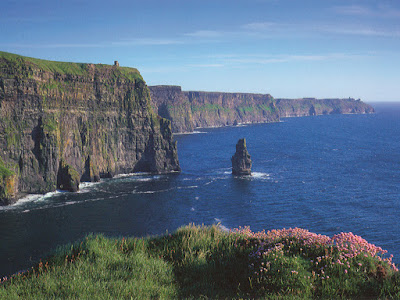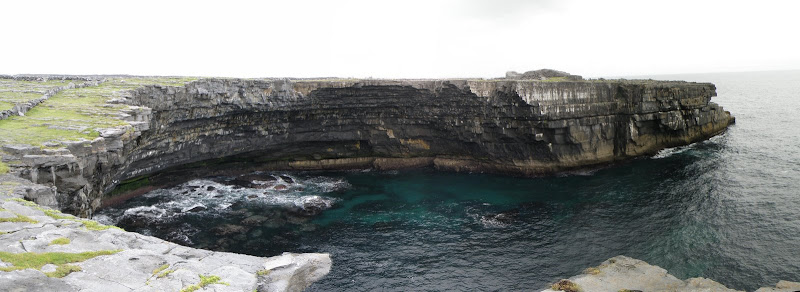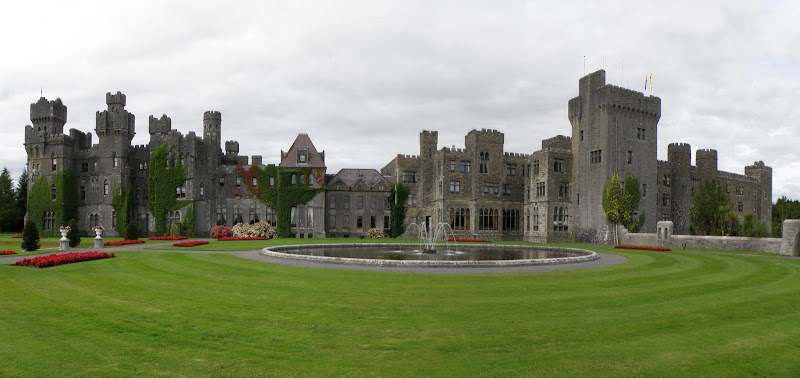Ireland Pt. 3
The Burren and the Birthday
It's foggy and drizzly as we head to the Cliffs of Moher, pronounced More. The cliffs rise from 120 to 214 meters (394 ft to 702 ft) above the Atlantic Ocean. The Cliffs of Moher are amongst the most popular tourist destinations in Ireland, drawing almost one million visitors a year.
What we were supposed to see...


What we did see...
Apparently these cliffs have the most scenic views in Ireland, but we couldn't see anything. We could barely even see O'Brien's Tower, it sits at the highest point of the Cliffs of Moher. The tower was built on the Cliffs of Moher in 1835 by local landlord Sir Cornellius O'Brien as an observation tower for the hundreds of Victorian tourists that frequented the cliffs during the time.
There is signs everywhere warning about climbing the walls, but one guy doesn't listen, he climbed over and took a picture... of white. It would've been very easy for him to walk right over the edge. Apparently 3 weeks earlier someone fell off the edge and died. A little more disturbing is the signs that say "Need to talk to someone?" along with a helpline phone number.
After 1.5 hours we had only 2 small glimpses. For just a moment we saw the base of the cliffs, and then about a minute later it was all white again. Time to leave. Basically we paid €8 to park.
After leaving the cliffs, we pulled over to the side of the road to see Leamanah Castle, a 15th century fortified tower house. We are alone as we check out the broken shell of the building, as soon as we are getting back in car a tour bus pulls up, and 60 people pile out to see it. Timing!
We pull into a side road to check out the Carron Church ruins (carn=mound of stones), another abandoned church along the way. As we are walking back to our car a van pulls up, we think we may be in trouble for trespassing, but the owner of the property asks us "can you close the gate?"
Next stop is the Caherconnell (Cahercommaun) ring fort, an ancient and exceptionally well preserved Celtic Ring Fort, probably inhabited from around 500 to 1500 AD. There is a £5 fee if you want to watch the 15 minute virtual tour, access to the fort is free, we chose the free part.
A womans skeleton dated from the 15th century, was found in a center tomb. It's always interesting to see how these stacked rocks fort continue to exist after such a long time.
A short distance away is Poulnabrone Dolmen (Poll na mBrón in Irish meaning "hole of sorrows"), an ancient portal tomb. Dating back to the Neolithic period, probably between 4200 BC to 2900 BC, it was a grave chamber, where the remains of 30 skeletons were found. Not all the remains were from this area, and seem to have been brought here as a final portal to the afterlife. The 10 foot high capstone may be up to 100 tons in weight, the ranger guesses that the side stones were set, and then surrounded by gravel to slide the capstone into place, then the gravel was removed.
The Ranger we met tells us many stories; the gravel, the history of the Dolmen, even about a tourist who showed up with a shovel and trowel to bury his fathers ashes. Apparently it was in his fathers will, he had to be turned away without defacing a national monument.
The area surrounding the Dolmen is visibly part of the Burren. The Burren (Irish: Boireann, meaning "great rock") is a flat limestone bedrock region. It is one of the largest landscapes of it's style in Europe. The region measures approximately 250 square kilometres (100 square miles).
In 1652, Edmund Ludlow stated, "(The Burren) is a country where there is not enough water to drown a man, wood enough to hang one, nor earth enough to bury him"
Our last stop in The Burren area is Ailwee Caves, touted as Ireland's premier show caves. The remains of now 1000 year extinct brown bears were found here. The cave was discovered by a local farmer in 1940, when his dog chased a rabbit into a small opening in the rocks.
The tour takes you down 300 yards of an old underground river, we are warned about the water on the side of the path, and not more than 1 minute in, I step completely into the puddle, up to my ankle. Each step I take along the way makes that recognizable squoosh sound. It wasn't the most impressive caves we have seen, but with a mix of stalactites, stalagmites, waterfalls and calcified rivers it was pretty cool to see. I changed my socks when we got back to the car.
We skipped the bird of prey exhibit at Ailwee, since it was pouring rain, and I had just done the falconry training at home. Instead we checked out the Farm shop, more specifically the cheese portion of the farm shop. We found an amazing local garlic herb cheese, and departed the shop with a box of tasty crackers and enough cheese to finish them, our version of take-out lunch.
As you drive around Ireland, it's important to pay attention to the signs, which way do we go?
Before getting to Galway we made a brief photo stop in Kinvarra, the 16th century Dunguaire Castle. The castle's 75-foot tower and its wall have been restored to excellent condition, and it is now host to a medieval banquet including mead, irish tales, folk songs and of course, wenches.
As we rolled into Galway, rolling became crawling, crawling became parked. Traffic was horrendous, and we were running out of time to get to the Tourist Info Centre. When we finally got close enough, Norine jumped out and went to the TI to book a room. When Norine came out I was still sitting in traffic in front of the building. After sitting in traffic for almost an hour, we decided not to stay in Galway, instead staying further north. There was one sight to see before moving on.
The Cathedral of St Nicolas opened in 1965, one of the last great stone churches built in Europe.
It was a little awkward to look at the cathedral as they were having a service. Two thousand worshippers all face a central altar. We heard the priest pray for all the children of Ireland who are very anxious awaiting the results of their tests. With Mahogany pews, green Connemara marble floors and Canadian cedar ceilings, it is a striking building on the inside.
After sneaking quietly out of the Cathedral in Galway, we drove 36 km to the very small fishing town of Rossaveal. Our B&B is conveniently located just a short walk from the ferries to the Aran Islands. Hernon's B&B was very unkempt... lots of cobwebs and lots of spiders, very musty. We left the windows open and went for a walk in the rain to the only restaurant in town.
The waitresses at the restaurant were very anxious waiting for the results of their tests, Irelands equivalent to Provincials or SAT's, the priest in Galway was right. We had an excellent dinner, both meals recommended by our waitress, she couldn't recommend the lamb, because she has sheep at home, I couldn't eat lamb after hearing she had sheep at home. There was only a few other people, when we got back to the B&B, we found out most of them were staying at the same place.
Aran Islands - Inishmore
On the morning of my Birthday we had plans to do something special, take the 1/2 hour ferry to the island of Inishmore in the Aran Islands. The Aran's are a group of three islands located on the west coast of Ireland. Irish is the main spoken language on all three islands.
We had three choices to tour the island, we could take one of the many tourist mini-vans packed with strangers, we could rent a bike or we could take a horse and buggy. While we were deciding, a local named Sean approached us, he would take us in his horse drawn carriage for 3 hours, up to the old fort and along the shoreline. Since it was a special day, we chose to go with Sean.
Norine and I, and Sean get into the buggy built for two, and his horse 'Prince' starts us on our way. With such a strong Irish language in the Aran Islands, I ask Sean if Prince speaks Irish, he says ayuh... as he keeps repeating "gowun" to the white Connemara pony. So I ask him what he is saying, and we all laugh when he tells us he is just saying "Go On".
We wind our way along quaint narrow roads, bikes pass us, and a few mini-vans pass us, until we cut over to the shoreline road. We pass small farms, old house ruins, and a cute roadside shop selling snacks and drinks. Even the dog has his own cute little house.
The main destination of our tour is Dún Aengus (Dún Aonghasa) a 2000 yr old celtic fort sitting on the edge of a 100 metre (300 ft) cliff. For most of the morning there was a light drizzle, as soon as we arrived at our first stop it got sunny... off comes the rain coats.
It's a bit of a hike up to the fort via a gravel trail eventually becoming limestone steps. The fields surrounding the fort have the same flat limestone landscape as we saw in the Burren.
With a 300 ft drop and waters that are 300 ft deep at bottom of the cliffs, it is not a safe place for kids or the wizzined (sic), but there are no guard rails here, there isn't even warning signs.
Dún Aengus fort is either built in the Iron Age, or the 2nd century BC. The fort consists of a series of four concentric walls of dry stone construction, the original shape was presumably oval or D-shaped, but parts of the cliff and fort have since collapsed into the sea. It was probably originally constructed as a circular ring fort several hundred metres from the coast, its present precarious position being the result of centuries of coastal erosion.
After spending some time enjoying the magnificent views from the cliffs and exploring the fort, we hiked back down, overlooking the valley, and a smaller ring fort.
Prince is waiting for us when we come back down, and the rest of our ride would be in the sun.
We pass a nice sandy beach with blue waters, and further along seals play in the shallows, it seems the whole trip in the buggy we are passing one beautiful sight after another.
The whole day that we spend with Sean he is telling us stories of his lifelong home, what Island life is like, how it was when he grew up, and stories of the locals and the area, so interesting.
Sean and Prince dropped us back in the main town, and we had a quick lunch at a small cafe, before hiking across the island to the Black Fort aka Dún Dúchathair.
Again we cross limestone fields, much like the Burren. The fields on this island are the result of generations of farmers that have recovered farmland by creating soil with centuries of layering seaweed with limestone sand. Once we get closer to Dún Dúchathair there is no farmlands.
The cliffs are sectioned off with jig-sawed local stones to keep the sheep contained in their enclosed areas. The limestone cliffs are layered and eroding away like a hundred layers of old paint, breaking off piece by piece, and leaving behind a magnificent but rustic coastline.

The Black fort is also on a dramatic location, hanging on a crumbling cliff edge, and we are practically alone as we explore the area, with only a few other people around.
The hike back down is just as interesting, it's almost maze-like as we wind our way between rock walls, climbing rock fences, and hopefully ending up where we started. After a while we do end up back at the main road, not sure if the other people at the fort were as lucky. It's a nice casual walk, back past more rock walls, and curious locals just looking for some attention.
Back in town, we checked out the Irish wool store then took the ferry back to Rossaveal.
Back in Rossaveel, we opened the windows to air out our B&B, and as the sun is setting, we went for a spectacular Birthday dinner of Irish Beer and Pizza at the only restaurant in town. It's crazy busy, and there is only 1 girl working tonight. Every few minutes more people show up, finally after a few frantic calls someone comes to help her out. Although she had a heck of a time keeping up with all the tables, she gave us excellent service, from the first drinks to the yummy Bailey's and Strawberry cheesecakes we had for dessert. A pretty memorable birthday day all round!
Connemara
Connemara is one of the most scenic regions in Ireland. It is dominated by the Twelve Bens mountain range (Na Beanna Beola), dotted with lakes, and fringed by a ragged Atlantic coastline.
Heading North we entered the Connemara region, and started by searching out the Castle Kirke aka Hen's Castle - Caislean na Circe is one of the oldest mortared castles in Ireland. This Norman keep, placed in the direction of the cardinal compass points, was built early in the 12th Century. Legend has it that a witch and her hen built it on the island in one night, as it seemed to have just appeared overnight, stories of ghosts and spirits haunting the island still exist. Cromwell ruthlessly dismantled the castle in 1654, and it has remained a ruin ever since; but the massive walls, and the beautiful twelfth century ornamentation of doors and windows still remain.
After finding Castle Kirke, we headed back towards the coast, and continued through the Connemara region, stopping to admire scenic lakes, and the majestic mountains surrounding them. We even stopped at an odd statue with an even stranger sign.
This is Connemara - Iconn son of the Sea
Built in 1999 by Joyce Craft Shop
for no apparent reason

Our next destination was Clifden Castle, it was a little hard to find this abandoned castle. You enter what appears to be private property through a medieval looking gate and then hike down a trail for 5 minutes, rounding a corner suddenly there is the remains of the castle sitting alone in a farmers field with cows and horses. There is a sign warning about a bull, but we never saw it, joking that since I was wearing a red shirt, I may have to run for my life at any moment.
Clifden Castle was built by John d'Arcy in a Gothic Revival style about 1750. The house was only lived in for about 90 years before it was abandoned in the 1840's. The house fell into ruin and was stripped bare of anything that could be sold by the locals in order to feed themselves.
Off to one side is what appears to be an old Church building, maybe it was stables? We climbed the stone fence to get to it, and as we are getting closer, Norine finds a dead and rotting sheep, time to go, we don't need to look any closer at this building anyways.
One of the interesting features of this property are the standing stones. D'Arcy had these stones erected to mimic other standing stones around Ireland. The entire time we were there, we were alone at castle (not counting this horse). We passed a couple more people as we hiked up the trail back to our car, and warned them of the sheep so their kids wouldn't be traumatized, like we were.
From abandoned ruins we made our way to a much more dramatic building, the Kylemore Abbey. It is striking from the outside, but inside was a waste of time and money, €12 to look at 2 rooms.
Kylemore Abbey (Irish: Mainistir na Coille Móire) is a Benedictine monastery founded in 1920 on the grounds of Kylemore Castle which was built between 1863 and 1868 as a private home. The abbey was founded for Benedictine Nuns who fled Belgium in World War I. Today it functions as both a nunnery as well as an International girls' boarding School.
There is a small neo-Gothic church on the grounds (built between 1877 and 1881), it is a miniature replica of Norwich Cathedral, made from local green Connemara marble.

Kylemore Lake in front of the Abbey has scenic views of the Connemara mountains. We decided to skip the Victorian walled gardens and left to continue exploring the region.
There is lots of small lakes in this area, and several very large and scenic ones such as Lough Comb, we had to make several photo stops before we would get to our next point of interest.
As we are heading to the village of Cong we pass the Castle Kirke again, oops, didn't plan that very well. When we do arrive in Cong, the girl in the TI is extremely help, letting us look through a book of info and pictures on B&B's, find one we like and then she would call and book it for us.
We found what appeared to be a nice place in the city of Donegal, hopefully it's as nice as the pic.
Across the street from the TI is the Cong Abbey, Founded in the early 7th century, the abbey was destroyed by fire in the early 12th century. It was rebuilt several times up to the 13th century. It's a little disturbing that we found someone had peed in the upper area of the Abbey, no respect.
In the back of the Abbey there is a small bridge leading into a wooded trail. You can't just ignore that, so we cross the bridge and check out the trail... good choice!
Just a short distance down the trail is the monk’s fishing house, probably built in the 15th or 16th century, on the bank of the River Cong. There was holes in the floor that they fished through, and a line that went to the kitchen, so when a fish was caught, they knew it was time to get prepared.
The trail goes through a nice quiet forest alongside the river, and comes out at the impressive Medieval Ashford Castle. The castle was built in 1228 by the Anglo-Normans, and was expanded every 100 years or so, especially when the castle was purchased in 1852 by the Guinness family, who extended the estate to 26,000 acres (110 km2), built new roads, planted thousands of trees and added two large Victorian style extensions. In 1939 the Guinness family sold it, and it became a hotel. In 1952 John Wayne stayed there while making The Quiet Man in Cong and it's buildings, Ronald Reagan and Princess Grace stayed there too, and Pierce Brosnan had his wedding there.

It seems every corner that you turn, there is a new perspective on the castle, the clouds reflecting on Lough Comb, the flowers blooming, the ivy crawling, the fountain fountaining... We wandered the grounds, imagining staying in one of the rooms that start at €400 per night.
We walked back to town, past a small church and an impressive ivy covered home. Having not even heard of Cong before we left, it turned out to be one of the highlight stops of our trip.
From Cong it's a 2 hour drive to Donegal, along the way we passed two rather large structures, I'm assuming they are water towers, but we probably will never know what they really are.
We punched the GPS Long/Lat coordinates for our B&B, and it took us right to the front door... good thing because this place is outside of Donegal, in the boonies on Lough Eske. That's ok, it's a beautiful house overlooking the lake, and our hosts Mr and Mrs McGinty are so friendly and welcoming. Not only that, but they make a wicked breakfast to send us on our way in the morning.
The view of Lough Eske from our room
In the morning, Mr. McGinty gave one of the other guests a hard time for referring to the City of Londonderry, "Londonderry? What is that, I've never heard of it? The Irish have a City called Derry, the British have a city called Londonderry." After a few more good laughs about Irish customs and things to see in the north, Mrs McGinty booked us a place just outside of Derry (not Londonderry).
Donegal
We loaded up the Audi and decided to make a stop in the town of Donegal before heading north, of course we had to bring our umbrellas as it was raining. Donegal Town itself is famous for being the former home to the O'Donnell Clan, who played a pivotal role in Irish history. From the 15th to the 17th century, they provided the main opposition to the colonization of Ireland by England.
One of the most striking buildings situated in the centre of Donegal town, is the 15th century Donegal Castle on the banks of the River Eske. For most of the last two centuries, the majority of the buildings lay in ruins, but the castle was almost fully restored in the late 1990s.
There is a couple of very striking churches in Donegal town; the Protestant Church of Ireland which was built by stone masons in 1828, and St. Patrick's Church which was built in the 1930's. Only St Patrick's Church was open to see the impressive interior and it's round tower style bell tower.
With the rain really starting to come down we decided to check out a few shops, and maybe pick up some gifts to take home. When we wander into the "Wool n' things" store to look at tweed hats for my dad, we are all surprised to discover Mr. McGinty is there, he owns the store. We pick up a traditional Irish Tweed hat from the area, a few other souvenirs, and drive north.


